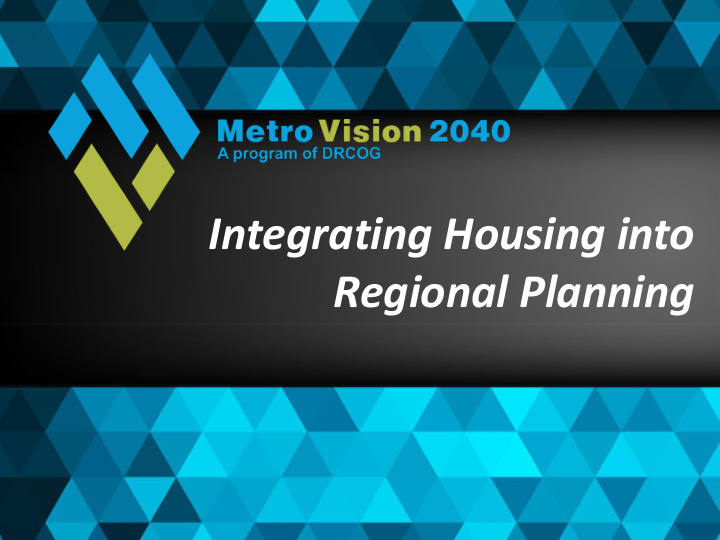



Integrating Housing into Regional Planning
Background SCI provides resources to more fully integrate housing and economic vitality into Metro Vision ‒ Housing and economic vitality identifies as areas of improvement to create a more holistic regional plan ‒ Fair Housing Equity Assessment (Required by HUD) ‒ Regional Housing Strategy – “the starting point…” ‒ DRCOG Board to consider if/how to integrate key findings and recommendations BBC Research and Consulting hired to complete FHEA and RHS Housing issue connected to other key topics
Metro Vision – “The Umbrella” Metro Vision Plan Growth and Development, Environment, Transportation 20+ Year “Vision” Transportation System 2035 Metro Vision 20 + Year “Vision” Regional Transportation Plan (RTP) Transportation System 2035 Fiscally Constrained 20 + Year Affordable RTP Transportation System Air Quality Conformity 2012-2017 6- Year Program of Transportation Improvement Funded Projects Program (TIP)
Housing Studies: FHEA and RHS
Stakeholder and Public Engagement Local governments Private sector developers (housing and land use Regional homelessness planners) experts Entitlement communities* Providers of housing Affordable housing opportunities for people professionals with disabilities Housing authorities Fair housing agencies * During and in advance of Strategy development
Stakeholder and Public Engagement Identified housing needs within the region – Top 3 Increase supply of housing for low to middle income households Expand and respond to the demand for transportation, housing and service options for people with disabilities and specifically seniors Increase economic opportunities for disadvantaged residents (access)
Public Engagement Feedback Targeted conversations (RCAP/ECAP) Scarcity of affordable options Neighborhood disinvestment - safety, crime, recreational opportunities, grocery Access to opportunity – jobs, training, schools, etc. Gentrification Discriminatory rental practices – fear of pursuing disputes
Growth Dynamics Region added over 1 million people between 1980 and 2010, but experienced only modest changes to the housing stock Majority of the region has experienced declining homeownership rates Incomes have generally kept pace with housing prices But those in poverty are facing historically high rents and low ‒ vacancy rates Also must consider rising cost of consumer goods ‒
Growth Dynamics The region will experience significant growth in the older adult population ‒ Much of this growth will happen in suburban and rural portions of the region The region should expect significant growth in residents with disabilities Consistent with national trends, the region has grown in ethnic and racial diversity (but with some variation across the region) Adams and Arapahoe significant increases, Denver no change ‒
Growth Dynamics Nearly half of the region’s minority residents live in racially/ethnically concentrated areas with high levels of poverty Region is among the most economically segregated in the country (2 nd to only NYC in share of households earning less than $40K who live in majority low-income Census Tract) Extreme mismatch between affordable housing and job center locations
Housing Affordability - Owning 2000 median price of homes listed or sold in the region = $189,000. In 2010 = $259,000 (up $70,000) Largest gains in Boulder County ($108,000) and Denver ($99,000) Change in proportionate shares of affordable homes increased in Adams and Weld counties Decreased in Boulder, Denver, Douglas counties
Housing Affordability - Renting $40,000 = Amount renters must earn to afford median rental unit Most affordable submarkets (vacancy at 2.8 percent – perhaps even lower) ‒ Northern Aurora ‒ Commerce City ‒ Brighton Denver has both most expensive and most affordable units ‒ Central/Downtown: must earn $60,000 to afford median rent
Housing: Links to Other Issues
Housing – Reg. Econ. Strategy Interviews with Economic Development Professionals Middle to upper skill and wage jobs have pretty good choices Lower incomes: affordability and stability a threat to economic opportunity Lack of entry level rental housing in peripheral suburban and exurban locations ‒ Difficulty attracting and retaining entry level employees Construction defects – potential impact on for-sale, market rate, affordable
Housing – SCI Corridor Efforts SCI Catalytic and Technical Assistance Projects ‒ East Corridor – Peoria Station 5.6 Acres of land owned by Aurora Housing Authority ‒ Northwest Corridor - Adams County Housing Authority 6.5 acres of multifamily and commercial land steps from the Westminster Station, both vacant and improved ‒ Gold Corridor – Housing Strategy Affordable Housing Creation and Preservation Strategy o Ensure continued housing affordability in the corridor o Determine strategies to meet future housing needs
Next Steps
Housing and Metro Vision 2040 Summaries distributed to MVPAC and DRCOG Board (May 2014) Metro Vision Issues Committee (July 2014) DRCOG Board briefing (TBD) ‒ FHEA and RHS bring together data and stakeholder input to inform regional strategies, including roles for DRCOG – only a piece of the puzzle ‒ Other efforts can inform supportive policy framework (Metro Vision 2040) ‒ New territory for DRCOG - Board support critical as the foundation is set
Integrating Housing into Regional Planning
Recommend
More recommend